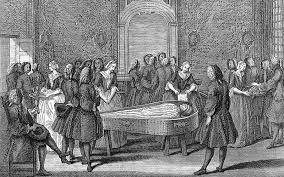The Forgotten Profession of Sin-Eating: A Look into a Fascinating yet Macabre Custom
- B
- Feb 6
- 2 min read
In the County of Hereford, a peculiar custom took place at family funerals from the early 1600s until the mid-19th century. Grieving family members would call upon a sin-eater, a person tasked with the responsibility of absorbing the deceased’s sins, allowing them to enter heaven unencumbered (Maple,1964).
This unusual profession was often reserved for the poor, who were willing to take on the role despite being shunned by their communities (Harrison, 2003). The sin-eater’s task was to consume a piece of bread or pastry placed on the chest or face of the deceased, which was believed to absorb the person’s sins (Sikes, 1880).
The ritual involved friends and family gathering around the deceased, drinking beer, singing, and mourning their passing. The body would then be brought out of the house, accompanied by a loaf of bread or pastry, a tankard of beer, and a sixpence, which were passed to the sin-eater to devour (Bennett,1994).
This custom was thought to enable the soul of the deceased to safely ascend to heaven. Despite their crucial role, sin-eaters were feared and ostracized by their communities, who believed their work was akin to witchcraft or dark magic (Harrison, 2003).

The Last Recorded Sin-Eater
The last known sin-eater was Richard Munslow, a respectable farmer from Ratlinghope, who died in 1906 (BBC,2006). Unlike most sin-eaters, who came from poor families, Munslow was wealthy and took on the role of kindness to his fellow villagers and to uphold an ancient tradition that had largely died out in the previous century.
In conclusion, the profession of sin-eating is a fascinating yet macabre custom that highlights the complexities of human culture and tradition. While this practice may seem strange and unsettling to modern sensibilities, it serves as a reminder of the importance of understanding and respecting the cultural heritage of our ancestors.
Until next time,
B!






Comments